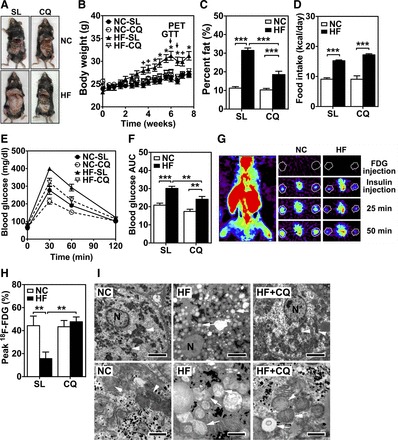Fig. 1.

Systemic administration of chloroquine (CQ) prevents high-fat diet-induced obesity and insulin resistance in mice. Adult (12 wk of age) male wild-type mice (C57BL/6) were on normal chow (NC) or high-fat diet (HF) for 8 wk, with daily injection (ip) of normal saline (SL) or CQ (60 mg/kg). A: anterior views of mice following euthanization showing the appreciable differences in body size and visceral adipose tissues through the abdominal incision following 8 wk of diet and pharmacological intervention. B: changes in body weight during the treatments (n = 12/group). + and *, P < 0.05 and P < 0.01, respectively, vs. NC-SL for each time point. C: %body fat measured by MRI. D: daily food intake based on consumed food weight. E: blood glucose level during glucose tolerance test (GTT). F: area under the curve (AUC) of blood glucose levels during GTT (n = 12/group). G: representative microPET images of [18F]FDG radioactivity in the whole body of a mouse and in the lower hindlimb muscles (at the position indicated by a line on the whole body image) during a dynamic scan following insulin (2 U/kg) injection at 25 and 50 min post-insulin injection (ip). H and I: radioactivity in hindlimb muscles 50 min post-insulin injection in [18F]fluorodeoxyglucose ([18F]FDG) microPET analysis (n = 10–12/group) (H) and transmission electron microscopy of liver from mice on NC or HF diet with daily normal saline (HF) or CQ injections (HF + CQ) (I). High-fat-induced mitochondrial pathology (arrows point to normal mitochondria, and arrowheads point to swelling mitochondria) was significantly attenuated by CQ injection. Bars equal 5 and 1 μm at top (low magnification) and bottom (high magnification), respectively. **P < 0.01; ***P < 0.001.
